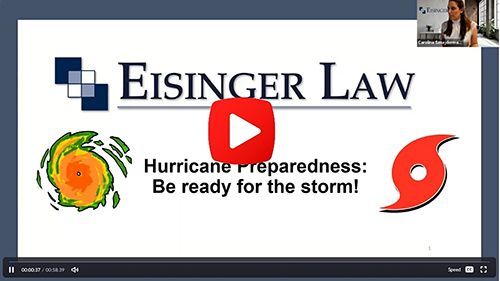As we enter hurricane season in Florida, it’s critical for Condominium and Homeowners associations to proactively prepare. During a State of Emergency, Florida law (Chapters 718 & 720, Florida Statutes) grants associations emergency powers that allow them to:
•Reschedule meetings with limited notice
•Relocate the association’s principal office
•Work with local governments on debris removal
•Restrict access to damaged or unsafe areas
•Shut down utilities (e.g., elevators, water, power) as needed for safety
•Levy special assessments without a vote of the owners
•These powers help associations act swiftly to protect people and property when time is of the essence.
Pre-Storm Actions for Associations:
•Document the Property
Take clear, date-stamped videos and photos of association property (buildings, amenities, equipment, landscaping) to support future insurance claims. Store digital copies in multiple secure locations.
•Secure Potential Hazards
Remove or tie down anything that could become a projectile in high winds—furniture, planters, maintenance tools, decorations, and loose landscaping materials.
•Review and Maintain Equipment
Check backup generators, fire alarms, pumps, and elevators. Replace batteries in emergency lighting and test all safety systems to ensure functionality during a power outage.
•Install Shutters and Protect Windows
Install hurricane shutters or board up common area windows. Strongly encourage unit owners to do the same.
•Maintain Communication Channels
Ensure resident contact information is current. Provide clear instructions for receiving updates via email, text, or the association’s website. Distribute your community’s hurricane preparedness plan.
•Print Essential Documents
Power and internet may be lost. Have printed copies of key documents: contact lists, insurance policies, vendor info, evacuation plans, and emergency procedures.
Post-Storm Priorities:
•Inspect and Document Damage
Take new date-stamped photos and videos to capture any storm-related damage. This helps preserve insurance claims and supports repair efforts.
•Clear Access Points
Remove debris from entryways to ensure residents and emergency personnel can safely access the property.
•Hold Emergency Meetings
Use board or member meetings (virtual or in-person) to share updates, coordinate repairs, and address resident concerns.
•Track and Prioritize Repairs
Create a detailed list of necessary repairs, including the location and nature of the damage.
•Keep Residents Informed
Regularly update your website, send email alerts, and post notices in high-traffic areas to keep everyone aware of developments and safety information.
•Reschedule meetings with limited notice
•Relocate the association’s principal office
•Work with local governments on debris removal
•Restrict access to damaged or unsafe areas
•Shut down utilities (e.g., elevators, water, power) as needed for safety
•Levy special assessments without a vote of the owners
•These powers help associations act swiftly to protect people and property when time is of the essence.
Pre-Storm Actions for Associations:
•Document the Property
Take clear, date-stamped videos and photos of association property (buildings, amenities, equipment, landscaping) to support future insurance claims. Store digital copies in multiple secure locations.
•Secure Potential Hazards
Remove or tie down anything that could become a projectile in high winds—furniture, planters, maintenance tools, decorations, and loose landscaping materials.
•Review and Maintain Equipment
Check backup generators, fire alarms, pumps, and elevators. Replace batteries in emergency lighting and test all safety systems to ensure functionality during a power outage.
•Install Shutters and Protect Windows
Install hurricane shutters or board up common area windows. Strongly encourage unit owners to do the same.
•Maintain Communication Channels
Ensure resident contact information is current. Provide clear instructions for receiving updates via email, text, or the association’s website. Distribute your community’s hurricane preparedness plan.
•Print Essential Documents
Power and internet may be lost. Have printed copies of key documents: contact lists, insurance policies, vendor info, evacuation plans, and emergency procedures.
Post-Storm Priorities:
•Inspect and Document Damage
Take new date-stamped photos and videos to capture any storm-related damage. This helps preserve insurance claims and supports repair efforts.
•Clear Access Points
Remove debris from entryways to ensure residents and emergency personnel can safely access the property.
•Hold Emergency Meetings
Use board or member meetings (virtual or in-person) to share updates, coordinate repairs, and address resident concerns.
•Track and Prioritize Repairs
Create a detailed list of necessary repairs, including the location and nature of the damage.
•Keep Residents Informed
Regularly update your website, send email alerts, and post notices in high-traffic areas to keep everyone aware of developments and safety information.
Watch Our Recorded Lunch & Learn: “Hurricane Preparedness – Be Ready Before the Storm”

